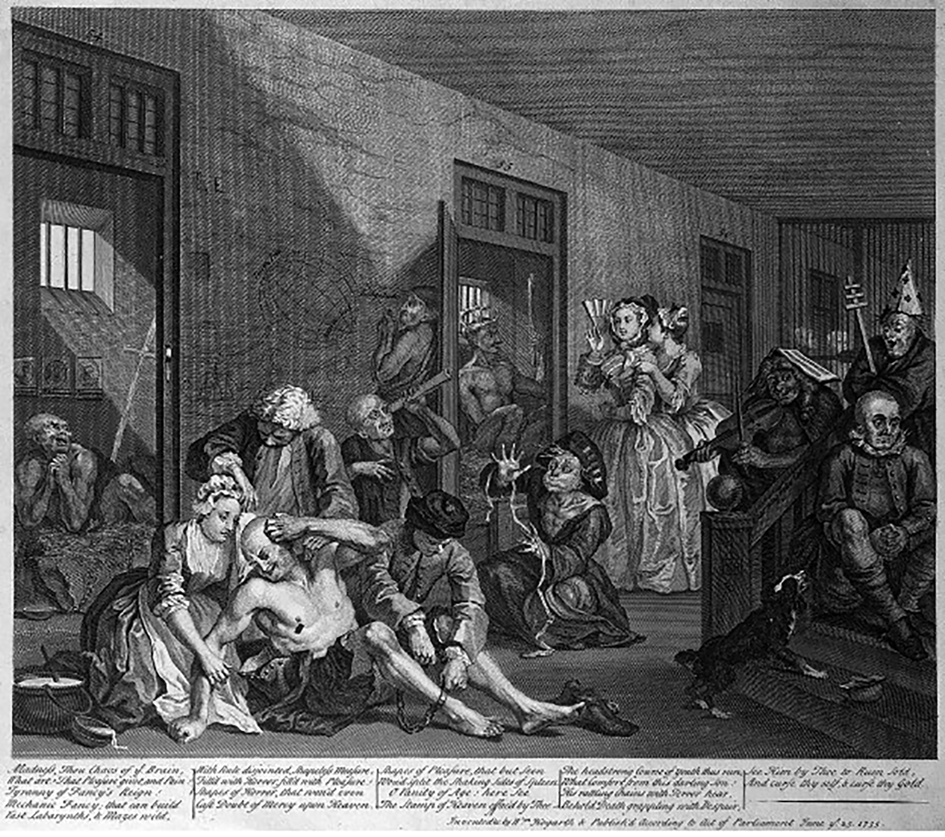In 1674 the Governors of Bethlem Royal Hospital in the City of London (aka Bedlam) decided to rebuild the hospital on a site at Moorfields, close to the original hospital in Bishopsgate. Robert Hooke, Curator of Experiments at the Royal Society, was appointed to design the building. He was a polymath especially versed in science and mathematics and had worked on many buildings with Christopher Wren. Most recently he had surveyed a part of London following the fire of 1666.
Hooke's design for the new Bethlem was highly original. All patients were accommodated in single rooms, which opened onto a broad corridor. The ‘gallery ward’ was derived from the layout of individual cells for monks in monasteries set alongside a gallery similar to those in some grand houses of the period. Although there are many paintings and etchings of the completed building, as well as elevations prepared as a guide to the builders, there are no known plans of the hospital still in existence. The building that succeeded the Moorfields Bethlem, that at St George's Fields, Lambeth, had a very similar layout, which is something of a guide. However, details of the interior are shown in a painting by William Hogarth.
Hogarth's series of eight paintings, A Rake's Progress (1733–1734), showing the social and moral decline of Tom Rakewell leading to his admission to Bedlam suffering from insanity, is well known. The eighth and final painting, The Madhouse, shows Tom being admitted to the hospital by attendants and comforted by his mistress, Sarah Young. The painting is probably a compilation of scenes that the painter had witnessed.
In 1735 Hogarth authorised the publication of an engraving of the painting which shows more detail than the original (Fig. 1). The image is reversed in the process of reproduction. The patients in their cells are naked, shackled to their straw beds and show evidence of mental disturbance, with postures of grandeur and morbid religious observance. In the gallery patients are drawing, singing, playing musical instruments, studying astronomy, adopting unusual postures or showing rigid inactivity. Unlike the painting, the engraving shows Tom being shackled by the hospital blacksmith. A gentlewoman and her companion, visitors to the hospital easily distinguished by their dress, show horror at what they are witnessing. Bewigged gentlemen beyond the grill are in the administrative part of the building and likely to be senior members of staff.

Fig. 1 ‘Scene in Bedlam’ (1735), engraving from The Rake's Progress by William Hogarth. Wellcome Collection (CC BY 4.0).
The engraving shows how the gallery ward was constructed and used. There are small, barred, unglazed windows to the individual cells facing south and the gallery is illuminated by glazed windows to the north. Some patients are detained in their cells but those who no longer require confinement use the gallery for recreational activities in the presence of attendants. Visitors pass through the galleries as they inspect the hospital. The practice of receiving visitors was necessary to attract funds for the hospital but an increasing source of criticism of the Governors. The galleries also served as corridors.
The importance of the new hospital was clearly recognised, for The King, Charles II, visited the building on 18 April 1678 shortly before it was completed. The building's architectural qualities were also noted, as the Royal party included the diarist John Evelyn, who wrote: ‘I went to see the new Bedlam Hospital, magnificently built, and most sweetly placed in Moorfields, since the dreadful fire of London’.







eLetters
No eLetters have been published for this article.